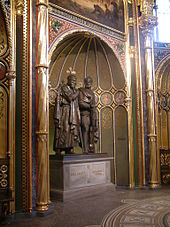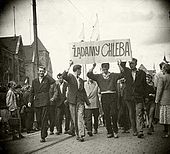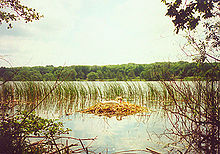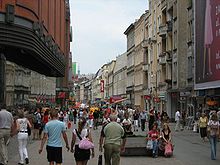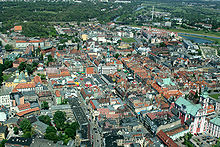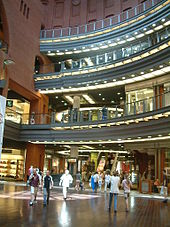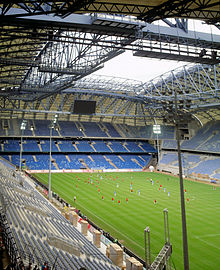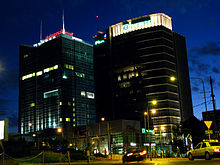- Poznań
-
Poznań Top: Grand Theatre, Stary Browar and towers
Upper Middle: Poznań Town Hall and market place
Lower Middle: Długa Street, Jesuit College
Bottom: Panorama of Poznań at dusk
Flag
Coat of armsCoordinates: 52°24′N 16°55′E / 52.4°N 16.917°E Country  Poland
PolandVoivodeship  Greater Poland
Greater PolandCounty city county Established 8th century Town rights 1253 Government – Mayor Ryszard Grobelny Area – City 261.85 km2 (101.1 sq mi) Highest elevation 154 m (505 ft) Lowest elevation 60 m (197 ft) Population (2009) – City 556,022 – Density 2,123.4/km2 (5,499.7/sq mi) – Metro 943,700 Time zone CET (UTC+1) – Summer (DST) CEST (UTC+2) Postal code 60-001 to 61-890 Area code(s) +48 61 Car plates PO Website http://www.poznan.pl/ Poznań [ˈpɔznaɲ] (
 listen) (Latin: Posnania; German: Posen; Yiddish: פוזנא or פּױזן Poyzn) is a city on the Warta river in west-central Poland, with a population of 556,022 in June 2009. It is among the oldest cities in Poland, and was one of the most important centres in the early Polish state, whose first rulers were buried at Poznań's cathedral. It is sometimes claimed to be the first capital of the kingdom of Poland.
listen) (Latin: Posnania; German: Posen; Yiddish: פוזנא or פּױזן Poyzn) is a city on the Warta river in west-central Poland, with a population of 556,022 in June 2009. It is among the oldest cities in Poland, and was one of the most important centres in the early Polish state, whose first rulers were buried at Poznań's cathedral. It is sometimes claimed to be the first capital of the kingdom of Poland.Poznań is now Poland's fifth largest city. It is the historical capital of the Wielkopolska ("Greater Poland") region, and is currently the administrative capital of the province called Greater Poland Voivodeship.
Poznań is an important centre of trade, industry, and education, and hosts regular international trade fairs. It was the host city for the United Nations Climate Change Conference in December 2008, a key stage in the creation of a successor to the Kyoto Protocol. Poznań was a candidate city for European Capital of Culture in 2016.
Contents
Names
The name Poznań probably comes from a personal name Poznan (from the Polish participle poznan(y) – "one who is known/recognized") and would mean "Poznan's town". It is also possible that the name comes directly from the verb poznać, which means "to get to know" or "to recognize". It may simply mean "known town".
The earliest surviving references to the city are found in the chronicles of Thietmar of Merseburg, written between 1012 and 1018: episcopus Posnaniensis ("bishop of Poznań", in an entry for 970) and ab urbe Posnani ("from the city of Poznań", for 1005). The city's name appears in documents in the Latin nominative case as Posnania in 1236 and Poznania in 1247. The phrase in Poznan appears in 1146 and 1244.
The city's full official name is Stołeczne Miasto Poznań ("The Capital City of Poznań"), in reference to its role as a centre of political power in the early Polish state. Poznań is known as Posen in German, and was officially called Haupt- und Residenzstadt Posen ("Capital and Residence City of Poznań") between 20 August 1910 and 28 November 1918. The Latin names of the city are Posnania and Civitas Posnaniensis. Its Yiddish name is פּױזן, or Poyzn.
The Russian version of the name, Познань (Poznan'), is of feminine gender, in contrast to the Polish name, which is masculine.
History
For centuries before the Christianization of Poland, Poznań (consisting of a fortified stronghold between the Warta and Cybina rivers, on what is now Ostrów Tumski) was an important cultural and political centre of the Polan tribe. Mieszko I, the first historically recorded ruler of the Polans, and of the early Polish state which they dominated, built one of his main stable headquarters in Poznań. Mieszko's baptism of 966, seen as a defining moment in the establishment of the Polish state, may have taken place in Poznań.
Following the baptism, construction began of Poznań's cathedral, the first in Poland. Poznań was probably the main seat of the first missionary bishop sent to Poland, Bishop Jordan. The Congress of Gniezno in 1000 led to the country's first permanent archbishopric being established in Gniezno (which is generally regarded as Poland's capital in that period), although Poznań continued to have independent bishops of its own. Poznań's cathedral was the place of burial of the early Piast monarchs (Mieszko I, Boleslaus I, Mieszko II, Casimir I), and later of Przemysł I and King Przemysł II.
The pagan reaction that followed Mieszko II's death (probably in Poznań) in 1034 left the region weak, and in 1038 Bretislaus I of Bohemia sacked and destroyed both Poznań and Gniezno. Poland was reunited under Casimir I the Restorer in 1039, but the capital was moved to Kraków, which had been relatively unaffected by the troubles.
In 1138, by the testament of Bolesław III, Poland was divided into separate duchies under the late king's sons, and Poznań and its surroundings became the domain of Mieszko III the Old, the first of the Dukes of Greater Poland. This period of fragmentation lasted until 1320. Duchies frequently changed hands; control of Poznań, Gniezno and Kalisz sometimes lay with a single duke, but at other times these constituted separate duchies.
In about 1249, Duke Przemysł I began constructing what would become the Royal Castle on a hill on the left bank of the Warta. Then in 1253 Przemysł issued a charter to Thomas of Guben (Gubin) for the founding of a town under Magdeburg law, between the castle and the river. Thomas brought a large number of German settlers to aid in the building and settlement of the city – this is an example of the German eastern migration (Ostsiedlung) characteristic of that period.[1][2] The city (covering the area of today's Old Town neighbourhood) was surrounded by a defensive wall, integrated with the castle.
In reunited Poland, and later in the Polish–Lithuanian Commonwealth, Poznań was the seat of a voivodeship. The city's importance began to grow in the Jagiellonian period, due to its position on trading routes from Lithuania and Ruthenia to western Europe. It would become a major centre for the fur trade by the late 16th century. Suburban settlements developed around the city walls, on the river islands and on the right bank, with some (Ostrów Tumski, Śródka, Chwaliszewo, Ostrówek) obtaining their own town charters. However the city's development was hampered by regular major fires and floods. On 2 May 1536 a blaze destroyed 175 buildings, including the castle, the town hall, the monastery and the suburban settlement called St. Martin.[3] In 1519 the Lubrański Academy had been established in Poznań as an institution of higher education (but without the right to award degrees, which was reserved to Kraków's Jagiellonian University). However a Jesuits' college, founded in the city in 1571 during the Counter-Reformation, had the right to award degrees from 1611 until 1773, when it was combined with the Academy.
 Poznań (south-facing view) ca. 1617 by Frans Hogenberg and Georg Braun, Civitates Orbis Terrarum, Cologne 1618
Poznań (south-facing view) ca. 1617 by Frans Hogenberg and Georg Braun, Civitates Orbis Terrarum, Cologne 1618
In the second half of the 17th century and most of the eighteenth, Poznań was severely affected by a series of wars (and attendant military occupations, lootings and destruction) – the Second and Third Northern Wars, the War of the Polish Succession, the Seven Years' War and the Bar Confederation rebellion. It was also hit by frequent outbreaks of plague, and by floods, particularly that of 1736, which destroyed most of the suburban buildings. The population of the conurbation declined (from 20,000 around 1600 to 6,000 around 1730), and Bambergian and Dutch settlers (Bambrzy and Olędrzy) were brought in to rebuild the devastated suburbs. In 1778 a "Committee of Good Order" (Komisja Dobrego Porządku) was established in the city, which oversaw rebuilding efforts and reorganized the city's administration. However in 1793, in the Second Partition of Poland, Poznań, came under the control of the Kingdom of Prussia, becoming part of (and initially the seat of) the province of South Prussia.
The Prussian authorities expanded the city boundaries, making the walled city and its closest suburbs into a single administrative unit. Left-bank suburbs were incorporated in 1797, and Ostrów Tumski, Chwaliszewo, Śródka, Ostrówek and Łacina (St. Roch) in 1800. The old city walls were taken down in the early 19th century, and major development took place to the west of the old city, with many of the main streets of today's city centre being laid out.
In the Greater Poland Uprising of 1806, Polish soldiers and civilian volunteers assisted the efforts of Napoleon by driving out Prussian forces from the region. The city became a part of the Duchy of Warsaw in 1807, and was the seat of Poznań Department - a unit of administrative division and local government. However in 1815, following the Congress of Vienna, the region was returned to Prussia, and Poznań became the capital of the semi-autonomous Grand Duchy of Posen.
The city continued to expand, and various projects were funded by Polish philanthropists, such as the Raczyński Library and the Bazar hotel. The city's first railway, running to Stargard in Pommern (now Stargard Szczeciński), opened in 1848. Due to its strategic location, the Prussian authorities intended to make Poznań into a fortress city, building a ring of defensive fortifications around it. Work began on the citadel (Fort Winiary) in 1828, and in subsequent years the entire set of defences (Festung Posen) was completed.
A Greater Poland Uprising during the Revolutions of 1848 was ultimately unsuccessful, and the Grand Duchy lost its remaining autonomy, Poznań becoming simply the capital of the Prussian Province of Posen. It would become part of the German Empire with the unification of German states in 1871. Polish patriots continued to form societies (such as the Central Economic Society for the Grand Duchy of Poznań), and a Polish theatre (Teatr Polski, still functioning) opened in 1875; however the authorities made efforts to Germanize the region, particularly through the Prussian Settlement Commission (founded 1886). Germans accounted for 38% of the city's population in 1867, though this percentage would later decline somewhat, particularly after the region returned to Poland.
Another expansion of Festung Posen was planned, with an outer ring of more widely spaced forts around the perimeter of the city. Building of the first nine forts began in 1876, and nine intermediate forts were built from 1887. The inner ring of fortifications was now considered obsolete and came to be mostly taken down by the early 20th century (although the citadel remained in use). This made space for further civilian construction, particularly the Imperial Palace ("Zamek"), completed 1910, and other grand buildings around it (including today's central university buildings and the opera house). The city's boundaries were also significantly extended to take in former suburban villages: Piotrowo and Berdychowo in 1896, Łazarz, Górczyn, Jeżyce and Wilda in 1900, and Sołacz in 1907.
After World War I the Greater Poland Uprising (1918–1919) brought Poznań and most of the region under Polish control, confirmed by the Treaty of Versailles. The local populace had to acquire Polish citizenship or leave the country. This led to a significant decline of ethnic Germans, whose number decreased from 65,321 in 1910 to 5,980 in 1926 and further to 4,387 in 1934.[4] In the interwar Second Polish Republic, the city again became the capital of Poznań Voivodeship. Poznań's university (today called Adam Mickiewicz University) was founded in 1919, and in 1925 the Poznań International Fairs began. In 1929 the fairs site was the venue for a major National Exhibition (Powszechna Wystawa Krajowa, popularly PeWuKa) marking the tenth anniversary of independence; it attracted around 4.5 million visitors. The city's boundaries were again expanded in 1925 (to include Główna, Komandoria, Rataje, Starołęka, Dębiec, Szeląg and Winogrady) and 1933 (Golęcin, Podolany).
During the German occupation of 1939–1945, Poznań was incorporated into the Third Reich as the capital of Reichsgau Wartheland. Many Polish inhabitants were executed, arrested, expelled to the General Government or used as forced labour; at the same time many Germans and Volksdeutsche were settled in the city. The pre-war Jewish population of about 2,000 [5] were mostly murdered in the Holocaust. A concentration camp for perceived enemies was set up in Fort VII, one of the 19th-century perimeter forts (the camp was later moved to Żabikowo south of Poznań). The Nazi authorities significantly expanded Poznań's boundaries to include most of the present-day area of the city; these boundaries were retained after the war. Poznań fell to the Red Army (assisted by Polish volunteers) on 23 February 1945 following the Battle of Poznań, in which the German army conducted a last-ditch defence in line with Hitler's designation of the city as a Festung. The Citadel was the last point to fall, and the fighting left much of the city (particularly the Old Town) in ruins.
Due to the expulsions of Germans from Polish territory (and the fact that many Germans had left as the Soviets advanced), Poznań's post-war population was almost uniformly Polish. The city again became a voivodeship capital; in 1950 the size of Poznań Voivodeship was reduced, and the city itself was given separate voivodeship status. This status was lost in the 1975 reforms, which also significantly reduced the size of Poznań Voivodeship.
The Poznań 1956 protests are seen as an early expression of resistance to communist rule. In June 1956, a protest by workers at the city's Cegielski locomotive factory developed into a series of strikes and popular protests against the policies of the government. After a protest march on June 28 was fired on, crowds attacked the communist party and secret police headquarters, where they were repulsed by fire. Riots continued for two days until being quelled by the army; 67 people were killed according to official figures.
The post-war years had seen much reconstruction work on buildings damaged in the fighting. From the 1960s onwards intensive housing development took place, consisting mainly of pre-fabricated concrete blocks of flats, especially in Rataje and Winogrady, and later (following its incorporation into the city in 1974) Piątkowo. Another infrastructural change (completed in 1968) was the rerouting of the river Warta to follow two straight branches either side of Ostrów Tumski.
The most recent expansion of the city's boundaries took place in 1987, with the addition of new areas mainly to the north, including Morasko, Radojewo and Kiekrz. The first free local elections following the fall of communism took place in 1990. With the Polish local government reforms of 1999, Poznań again became the capital of a larger province (Greater Poland Voivodeship). It also became the seat of a powiat ("Poznań County"), with the city itself gaining separate powiat status.
Recent infrastructural developments include the opening of the fast tram route (Poznański Szybki Tramwaj, popularly Pestka) in 1997, and Poznań's first motorway connection (part of the A2 autostrada) in 2003. In 2006 Poland's first F-16 Fighting Falcons came to be stationed at the 31st Air Base in Krzesiny in the south-east of the city.
Poznań continues to host regular trade fairs and international events, including the United Nations Climate Change Conference. It is one of the planned host cities for the 2012 European Football Championship.
Geography

A panoramic view of Poznań, taken from the city's north-eastern surburbs in Nowe Miasto Poznań covers an area of 261.3 km2 (100.9 sq mi), and has coordinates in the range 52°17'34''–52°30'27''N, 16°44'08''–17°04'28''E. Its highest point, with an altitude of 157 m (515 ft), is the summit of Góra Moraska (Morasko Hill) within the Morasko meteorite nature reserve in the north of the city. The lowest altitude is 60 m (197 ft), in the Warta valley.
Poznań's main river is the Warta, which flows through the city from south to north. As it approaches the city centre it divides into two branches, flowing west and east of Ostrów Tumski (the cathedral island) and meeting again further north. The smaller Cybina river flows through eastern Poznań to meet the east branch of the Warta (that branch is also called Cybina – its northern section was originally a continuation of that river, while its southern section has been artificially widened to form a main stream of the Warta). Other tributaries of the Warta within Poznań are the Junikowo Stream (Strumień Junikowski), which flows through southern Poznań from the west, meeting the Warta just outside the city boundary in Luboń; the Bogdanka and Wierzbak, formerly two separate tributaries flowing from the north-west and along the north side of the city centre, now with their lower sections diverted underground; the Główna, flowing through the neighbourhood of the same name in north-east Poznań; and the Rose Stream (Strumień Różany) flowing east from Morasko in the north of the city. The course of the Warta in central Poznań was formerly quite different than today: the main stream ran between Grobla and Chwaliszewo, which were originally both islands. The branch west of Grobla (the Zgniła Warta – "rotten Warta") was filled in late in the 19th century, and the former main stream west of Chwaliszewo was diverted and filled in during the 1960s. This was done partly to prevent floods, which did serious damage to Poznań frequently throughout history.
Poznań's largest lake is Jezioro Kierskie (Kiekrz Lake) in the extreme north-west of the city (within the city boundaries since 1987). Other large lakes include Malta (an artificial lake on the lower Cybina, formed in 1952), Jezioro Strzeszyńskie (Strzeszyn Lake) on the Bogdanka, and Rusałka, an artificial lake further down the Bogdanka, formed in 1943. The latter two are popular bathing places. Kiekrz Lake is much used for sailing, while Malta is a competitive rowing and canoeing venue.
The city centre (including the Old Town, the former islands of Grobla and Chwaliszewo, the main street Święty Marcin and many other important buildings and districts) lies on the west side of the Warta. Opposite it between the two branches of the Warta is Ostrów Tumski, containing Poznań Cathedral and other ecclesiatical buildings, as well as housing and industrial facilities. Facing the cathedral on the east bank of the river is the historic district of Śródka. Large areas of apartment blocks, built from the 1960s onwards, include Rataje in the east, and Winogrady and Piątkowo north of the centre. Older residential and commercial districts include those of Wilda, Łazarz and Górczyn to the south, and Jeżyce to the west. There are also significant areas of forest within the city boundaries, particularly in the east adjoining Swarzędz, and around the lakes in the north-west.
For more details on Poznań's geography, see the articles on the five districts: Stare Miasto, Nowe Miasto, Jeżyce, Grunwald and Wilda.
Climate
The climate of Poznań is continental humid with relatively cold winters and fairly hot summers. Snow is common in winter, when night-time temperatures are typically below zero. In summer temperatures may often reach 30 °C (86 °F). Annual rainfall is less than 500 mm, among the lowest in Poland. The rainiest month is July, mainly due to short but intense cloudbursts and thunderstorms. The number of hours of sunshine is among the highest in the country.
Climate data for Poznań Month Jan Feb Mar Apr May Jun Jul Aug Sep Oct Nov Dec Year Record high °C (°F) 15.0
(59.0)16.6
(61.9)24.1
(75.4)30.0
(86.0)34.0
(93.2)36.2
(97.2)38.2
(100.8)37.7
(99.9)34.1
(93.4)27.3
(81.1)20.2
(68.4)16.8
(62.2)38.2
(100.8)Average high °C (°F) 2.3
(36.1)2.9
(37.2)8.3
(46.9)13.6
(56.5)19.4
(66.9)22.1
(71.8)24.6
(76.3)24.5
(76.1)19.3
(66.7)13.9
(57.0)6.7
(44.1)3.2
(37.8)13.4 Daily mean °C (°F) −1.2
(29.8)−0.7
(30.7)4.0
(39.2)9.8
(49.6)14.9
(58.8)18.2
(64.8)20.1
(68.2)19.8
(67.6)15.3
(59.5)9.9
(49.8)4.4
(39.9)0.2
(32.4)9.6 Average low °C (°F) −4.6
(23.7)−4.3
(24.3)−0.3
(31.5)6.0
(42.8)10.3
(50.5)14.3
(57.7)15.5
(59.9)15.1
(59.2)11.3
(52.3)5.9
(42.6)2.1
(35.8)−2.8
(27.0)5.7 Record low °C (°F) −28.5
(−19.3)−27.6
(−17.7)−21.3
(−6.3)−6.8
(19.8)−3
(26.6)1.1
(34.0)4.7
(40.5)3.0
(37.4)−3.8
(25.2)−6.9
(19.6)−15.2
(4.6)−22.4
(−8.3)−28.5
(−19.3)Precipitation mm (inches) 25
(0.98)23
(0.91)30
(1.18)38
(1.5)45
(1.77)62
(2.44)70
(2.76)58
(2.28)35
(1.38)39
(1.54)37
(1.46)30
(1.18)492
(19.37)% humidity 81 82 75 68 63 68 70 72 74 77 80 82 74 Avg. precipitation days 14 12 11 9 11 12 13 13 9 12 14 12 142 Sunshine hours 56 67 118 179 230 237 236 229 171 122 55 40 1,740 Source: Polish Central Statistical Office Administrative division
Poznań is divided into 42 neighbourhoods (osiedles), each of which has its own elected council with certain decision-making and spending powers. The first uniform elections for these councils covering the whole area of the city were held on 20 March 2011.
For certain administrative purposes, the old division into five dzielnicas is used (although these ceased to be governmental units in 1990). These were:
- Stare Miasto ("Old Town"), population 161,200, area 47.1 km2 (18.2 sq mi), covering the central and northern parts of the city
- Nowe Miasto ("New Town"), population 141,424, area 105.1 km2 (40.6 sq mi), including all parts of the city on the right (east) bank of the Warta
- Grunwald, population 125,500, area 36.2 km2 (14.0 sq mi), covering the south-western parts of the city
- Jeżyce, population 81,300, area 57.9 km2 (22.4 sq mi), covering the north-western parts of the city
- Wilda, population 62,290, area 15.0 km2 (5.8 sq mi), in the southern part of the city
Economy
Poznań has been an important trade centre since the Middle Ages. Starting in the 19th century, local heavy industry began to grow. Several major factories were built, including the Hipolit Cegielski steel mill and railway factory (see H. Cegielski - Poznań S.A.).
Nowadays Poznań is one of the major trade centers in Poland. Poznań is regarded as the second most prosperous city in Poland after Warsaw. The city of Poznań produced PLN 31.8 billion of Poland's gross domestic product in 2006. The city also boasts a GDP per capita of 200,4% (2008) of Poland's average. Furthermore, Poznań had very low unemployment rate of 2.3% as of May 2009. For comparison, Poland's national unemployment rate was over 10%.
Many Western European companies have established their Polish headquarters in Poznań, or in the nearby towns of Tarnowo Podgórne and Swarzędz. Most foreign investors are German and Dutch companies (see List of corporations in Poznań), along with a few others. Investors are mostly from the food processing, furniture, automotive and transport and logistics industries. Foreign companies are primarily attracted by low labour costs, but also by the relatively good road and railway network, good vocational skills of workers and relatively liberal employment laws.
The recently built Stary Browar shopping center contains many high-end shops and is considered one of the best in Europe.[who?] Other notable shopping centers in the city include Galeria Malta, one of the largest in Central Europe, and the shops at the Hotel Bazar, a historical hotel and commercial center in the Old Town.
Transport
Poznań has an extensive public transport system, consisting of trams (see Tramways in Poznań, especially Poznański Szybki Tramwaj) and urban and suburban buses. The main railway station is Poznań Central Station to the south-west of the city centre; there is also the smaller Poznań Wschód and Poznań Garbary station north-east of the centre, and a number of other stations on the outskirts of the city. The main east-west A2 motorway runs south of the city; other main roads run in the directions of Warsaw, Bydgoszcz, Wągrowiec, Oborniki, Katowice, Wrocław, Buk and Berlin. An intensive programme of road building and improvement in and around the city is underway in preparation for the hosting of matches in the Euro 2012 football championships. Poznań has also one of the biggest airports on the west of Poland called Poznań-Ławica Airport. In 2010 it handled approximately 1.5 million passengers.
Culture and sights
Poznań has many historic buildings and sights, mostly concentrated around the Old Town and other parts of the city centre. Many of these lie on the Royal-Imperial Route in Poznań – a tourist walk leading through the most important parts of the city showing its history, culture and identity.
Perhaps the most important cultural event in Poznań is the annual Malta theatre festival, which takes place at many city venues usually in late June and early July. It hosts mainly modern experimental off-theatre performances, often taking place on squares and other public spaces. It also includes cinema, visual, music and dancing events.
Classical music events include the Henryk Wieniawski Violin Competition (held every 5 years), and classical music concerts by the city's Philharmonic Orchestra held each month in the University Aula. Especially popular are concerts by the Poznań Nightingales.
Every year on the 11th of November, Poznanians celebrate The Day of St. Marcin Street. A procession of horses, with St. Marcin at the head, parades along St Marcin Street, in front of The Imperial Castle. Everybody can eat delicious croissants, the regional product of Poznań.
Poznań hosted the 2009 European Young Adults Meeting of the ecumenical Christian Taizé Community.
Poznań also stages the "Ale Kino!" International Young Audience Film Festival in December and the "Off Cinema" festival of independent films. Poznań has several cinemas, including both multiplexes and smaller cinemas, an opera house and several other theatres, as well as museums.
The "Rozbrat" squat serves not only as a home for squatters, but also as a centre of independent and open-minded culture. It hosts frequent gigs, as well as an anarchistic library, vernissages, exhibitions, annual birthday festival (each October), poetry evenings, graffiti festivals and so on.
The city centre has many clubs, pubs and coffee houses, mainly in the area of the Old Town.
Education
Poznań has a few state-owned universities and a number of smaller, mostly private-run colleges and institutions of higher education. Adam Mickiewicz University (abbreviated UAM in Polish, AMU in English) is one of the most influential and biggest universities in Poland:
- University of Fine Arts in Poznań
- Academy of Music in Poznań
- Adam Mickiewicz University
- Poznań University of Economics
- Poznań University of Medical Sciences
- Poznań University of Technology
- Poznań University School of Physical Education
- University of Life Sciences in Poznań
Scientific and regional organizations
- Poznań Society of Friends of Arts and Sciences
- Poznań Supercomputing and Networking Center
- Western Institute
Sports
- AZS AWF Poznań – women's volleyball team playing in Polish Seria A Women's Volleyball League: 8th place in 2003/2004 season.
- AZS Poznań – women's basketball team playing in Torell Basket Liga: 2nd place in 2003/2004 season (formerly also called Danter AZS Poznań and Stary Browar AZS Poznań)
- KKS Lech Poznań – men's football team (Polish Champion: 1983, 1984, 1990, 1992, 1993, 2010; Polish Cup winner 1982, 1984, 1988, 2004, 2009 ; Polish SuperCup winner 1990, 1992, 2004, 2009)
- UKS Stoper Poznań – men's football team
- KS AZS AWF Poznań – men's field hockey team
- KS Energetyk – rhythmic gymnastics club
- KS Pocztowiec Poznań – men's field hockey team
- KTKFiT Błękitny Express Lech Poznań – men's field hockey team
- Lake Malta in Poznań hosted the World Rowing Championships in 2009 and has previously hosted some regattas in the Rowing World Cup. It also hosted the ICF Canoe Sprint World Championships (sprint canoe) in 1990 and 2001, and will do so again in 2010.
- Malta Ski – year-long skiing complex (hosting minor sport competitions), toboggan run, minigolf course
- MKS Dąbrówka – rhythmic gymnastics club, synchronized swimming
- Polonia Poznań – men's football team
- PSŻ Poznań – motorcycle speedway team
- SSW Malta Poznań – roller skating club
- TPS Winogrady Poznań – men's football team
- UKS Szóstka – synchronized swimming, football
- UKS Wanda – synchronized swimming
- U-19 Euro Championship in VI 2006 – Open and Final.
- Warta Poznań – men's football team (Polish Champion: 1929, 1947), currently plays in the Polish First League.
- WKS Grunwald Poznań – sports club with sections in field hockey, shooting, wrestling, handball and tennis.
- KS Sobieski Poznań – wrestling.
Politics
Municipal politics
Since the end of the communist era in 1989, Poznań municipality and suburban area have invested heavily in infrastructure, especially public transport and administration. That results in a massive investment from foreign companies in Poznań as well as in communities west and south of Poznań (namely, Kórnik and Tarnowo Podgórne). One of the most important values of Poznań is the positive attitude of public administration towards investments, and less bureaucracy than elsewhere in Poland.
City investments into transportation were mostly into public transport. While the number of cars since 1989 has at least doubled, the policy of improving public transport gave good effects. Limiting car access to the city center, building new tram lines (including Poznański Szybki Tramwaj) and investing in new rolling stock (such as modern Combino trams by Siemens and Solaris low-floor buses) actually increased the level of ridership. This is a notable success, even considering the fact that Polish society only possesses about half of the "old EU"'s purchasing power, hence not everybody can afford to own a car.
Future investments into transportation include the construction of a third bypass of Poznań, and the completion of A2 (E30) motorway towards Berlin. New cycle lanes are being built, linking to existing ones, and an attempt is currently being made to develop a Karlsruhe-style light rail system for commuters. All this is made more complicated (and more expensive) by the heavy neglect of transport infrastructure throughout the Communist era.
Constituency
Members of Sejm elected in 2005 from Poznań constituency:
- Arkady Radosław Fiedler, PO
- Waldy Dzikowski, PO
- Maria Pasło-Wiśniewska, PO
- Dariusz Lipiński, PO
- Michał Stuligrosz, PO
- Tomasz Górski, PiS
- Jan Filip Libicki, PiS
- Małgorzata Stryjska, PiS
- Jacek Tomczak, PiS
- Krystyna Łybacka, SLD
Members of European Parliament elected from Poznań constituency:
- Filip Kaczmarek, PO
- Jan Kułakowski, Unia Wolności
- Marcin Libicki, PiS
- Jan Masiel, Samoobrona
- Marek Siwiec, SLD
- Witold Tomczak, LPR
International relations
Twin towns
 Jyväskylä, Finland, since 1979
Jyväskylä, Finland, since 1979 Kharkiv, Ukraine, since 1998
Kharkiv, Ukraine, since 1998 Nablus, Palestinian Authority, since 1997
Nablus, Palestinian Authority, since 1997 Nottinghamshire, United Kingdom, since 1994
Nottinghamshire, United Kingdom, since 1994 Pozuelo de Alarcón, Spain, since 1992
Pozuelo de Alarcón, Spain, since 1992
Sister cities
Gallery
-
Combino tram
-
Baroque Collegiate Church, built 1651–1701
-
Jesuit College established by King Sigismund III Vasa in 1611
Notable residents
See also: Category:People from Poznań- Anna Anderson (c. 1900–1984), pretender of Grand Duchess Anastasia of Russia
- Lothar von Arnauld de la Perière (1886–1941), German U-boat commander
- Isidor Ascheim (1891–1968), painter and printmaker
- Stanisław Barańczak (born 1946), poet
- Herbert Baum (1912–1942) resistance fighter
- Zygmunt Bauman (born 1925), sociologist
- Bernhard Baumeister (1828–1917), actor
- Józef Brzeziński, biologist
- Brigitte Burmeister (died 1940), novelist
- Heinrich Caro (1834–1910), chemist
- Hipolit Cegielski (1815–1868), businessman
- Dezydery Chłapowski (1788–1848), general
- August Cieszkowski (1814–1894), philosopher
- Antoni Czubiński (1928–2003), historian
- Leopold Damrosch (1832–1885), conductor
- Ludwig Dessoir, (1810–1874), actor
- Franciszek Dobrowolski (1830–1896), theater director
- Tytus Działyński (1796–1861), political activist
- Małgorzata Dydek (1974–2011), basketball player
- Akiva Eiger (1761–1837), Rabbi of Poznań (1815–1837)
- Jean Paul Ertel (1865–1933), composer
- Ewaryst Estkowski (1820–1856), teacher
- Fredrak Fraske (1872–1973), the last surviving United States veteran of the Indian Wars
- Johannes Gad (1842–1926), neurophysiologist
- Jean Gebser (1905–1973), human consciousness scientist
- Eduard Gerhard (1795–1867), archaeologist
- Friedrich Goltz (1834–1902), physiologist
- Konstanty Gorski (1859–1924), composer and violinist
- Paul von Hindenburg (1847–1934), Field Marshal and President of the Weimar Republic
- Maksymilian Jackowski (1815–1905), activist
- John Jonston (1603–1675), naturalist and physician
- Stefan Jurga (born 1946), professor and rector of Adam Mickiewicz University in Poznań (1996–2002)
- Jan A.P. Kaczmarek (born 1954), composer
- Richard Kandt (1867–1918), doctor and explorer
- Ernst Hartwig Kantorowicz (1895–1963), historian
- Marek Karpinski, computer scientist
- Günther von Kluge (1882–1944), Field Marshal
- Krzysztof Komeda (1931–1969), jazz musician
- Leo Königsberger (1837–1921), mathematician
- Antoni Kraszewski (1797–1870), politician
- Max Kretzer (1854–1941), writer
- Antoni Krzyżanowski, 19th century architect
- Jerzy Kurczewski, (1924–1995), boys choral conductor
- Gerard Labuda (born 1916), historian
- Arthur Liebehenschel (1901–1948), commandant of Auschwitz and Majdanek
- Paul Leonhardt (1877–1934), chess master
- Karol Libelt (1807–1875), philosopher
- Włodzimierz Łęcki (born 1937), politician and writer
- Andrzej Maleszka (born 1955), theatre and movie director
- Karol Marcinkowski (1800–1848), physician and social activist
- Władysław Markiewicz (born 1920), sociologist
- Teofil Matecki (1810–1886), philosopher
- Heinrich Mendelssohn (1881–1959), building tycoon
- Karl-Friedrich Merten (1905–1993), U-boat commander
- Maciej Mielżyński (1799–1870), politician
- Julius Moses (1868–1942), politician
- Małgorzata Musierowicz (born 1945), novelist
- Andrzej Niegolewski (1787–1857), colonel
- Władysław Niegolewski (1814–1880), politician
- Gustav Oelsner (1879–1956), architect
- Władysław Oleszczyński (1809–1866), sculptor
- Lilli Palmer (1914–1986), actress
- Janusz Pałubicki (born 1948), politician
- Kazimierz Piwarski, (1903–1968), historian
- Gustaw Potworowski (1800–1860), activist
- Tomasz Przybecki (born 1981), articled clerk
- Edward Raczyński (1786–1845), politician
- Cyryl Ratajski (1875–1942), mayor of Poznań
- Antoni Radziwiłł (1775–1833), aristocrat
- Marian Rejewski (1905–1980), cryptoanalist, Enigma codemachine codebreaker
- Richard Rothe ( 1799–1867), Lutheran theologian.
- Jerzy Różycki (1927–1932), cryptoanalist, Enigma codemachine codebreaker
- Dame Elisabeth Schwarzkopf (1915–2006), operatic coloratura-soprano, born in Jarocin
- Michał Sczaniecki (1910–1977), historian
- Józef Struś (1510–1568), scientist and mayor of Poznań
- Sir Paweł Edmund Strzelecki (July 20, 1797 – October 6, 1873), Polish explorer and geologist
- Stefan Stuligrosz (born 1920), choral conductor
- Rafał Szukała (born 1971), butterfly swimmer
- Roman Szymański (1840–1908), political activist
- Mirosław Szymkowiak (born 1976) football player
- Jerzy Topolski (1928–1998), historian
- Lech Trzeciakowski (born 1931), historian
- Jan Węglarz (born 1947), computer scientist
- Piotr Wiśniewski (born 1955), Statistician
- Zygmunt Wojciechowski, (1900–1955), historian and founder of the Western Institute
- Leon Wegner (1824–1873), economist
- Anna Wolff-Powęska, historian
- Henryk Zygalski (1906–1978), cryptoanalist, Enigma codemachine codebreaker
- Ryszard "Peja" Andrzejewski (born 1976), rapper
See also
- Tourism in Poland
- History of Poland
- Royal coronations in Poland including in Poznań cathedral
- Poznań Fortress
Footnotes
- ^ Brather, Sebastian (2001) (in German). Archäologie der westlichen Slawen. Siedlung, Wirtschaft und Gesellschaft im früh- und hochmittelalterlichen Ostmitteleuropa. Ergänzungsbände zum Reallexikon der germanischen Altertumskunde. 30. Walter de Gruyter. pp. 87, 156, 159. ISBN 3110170612.
- ^ Brather, Sebastian (2001) (in German). Archäologie der westlichen Slawen. Siedlung, Wirtschaft und Gesellschaft im früh- und hochmittelalterlichen Ostmitteleuropa. Ergänzungsbände zum Reallexikon der germanischen Altertumskunde. 30. Walter de Gruyter. p. 87. ISBN 3110170612. "Das städtische Bürgertum war auch in Polen und Böhmen zunächst überwiegend deutscher Herkunft. [English: Also in Poland and Bohemia were the burghers in the towns initially primarily of German origin.]"
- ^ J. Perles: Geschichte der Juden in Posen. In: Monatsschrift für Geschichte und Wissenschaft des Judentums. Vol. 13, Breslau 1864, pp. 321-334 (in German, online)
- ^ Kotowski, Albert S. (1998) (in German). Polens Politik gegenüber seiner deutschen Minderheit 1919-1939. Forschungsstelle Ostmitteleuropa, University of Dortmund. p. 56. ISBN 3-447-03997-3. http://books.google.de/books?id=KVg_tMs_ZPIC&pg=PA365&dq=Goetheschule+Graudenz#v=onepage&q=adelnau&f=false.
- ^ "Survival artist: a memoir of the Holocaust", Eugene Bergman, 2009, pg. 20
- ^ "Poznań Official Website - Twin Towns".
 (in Polish) © 1998–2008 Urząd Miasta Poznania. http://www.poznan.pl/mim/public/publikacje/pages.html?co=list&id=19&ch=20&instance=1017&lang=pl. Retrieved 2008-11-29.
(in Polish) © 1998–2008 Urząd Miasta Poznania. http://www.poznan.pl/mim/public/publikacje/pages.html?co=list&id=19&ch=20&instance=1017&lang=pl. Retrieved 2008-11-29. - ^ "Brno - Partnerská města" (in Czech). © 2006-2009 City of Brno. http://www.brno.cz/index.php?nav02=1985&nav01=34&nav03=1010&nav04=1016&nav05=1249&nav06=1272. Retrieved 2009-07-17.
- ^ "Hanover - Twin Towns" (in German). © 2007-2009 Hannover.de - Offizielles Portal der Landeshauptstadt und der Region Hannover in Zusammenarbeit mit hier.de. http://www.hannover.de/de/buerger/entwicklung/partnerschaften/staedte_regionspartnerschaften/index.html. Retrieved 2009-07-17.
Bibliography
- Collective work, Poznań. Dzieje, ludzie kultura, Poznań 1953
- Robert Alvis, Religion and the Rise of Nationalism: A Profile of an East-Central European City, Syracuse University Press, Syracuse 2005
- K. Malinowski (red.), Dziesięć wieków Poznania, t.1, Dzieje społeczno-gospodarcze, Poznań 1956
- Collective work, Poznań, Poznań 1958
- Collective work, Poznań. Zarys historii, Poznań 1963
- Cz. Łuczak, Życie społeczno-gospodarcze w Poznaniu 1815–1918, Poznań 1965
- J. Topolski (red.), Poznań. Zarys dziejów, Poznań 1973
- Zygmunt Boras, Książęta Piastowscy Wielkopolski, Wydawnictwo Poznańskie, Poznań 1983
- Jerzy Topolski (red.), Dzieje Poznania, Wydawnictwo PWN, Warszawa, Poznań 1988
- Alfred Kaniecki, Dzieje miasta wodą pisane, Wydawnictwo Aquarius, Poznań 1993
- Witold Maisel (red.), Przywileje miasta Poznania XIII-XVIII wieku. Privilegia civitatis Posnaniensis saeculorum XIII-XVIII. Władze Miasta Poznania, Poznańskie Towarzystwo Przyjaciół Nauk, Wydawnictwa Żródłowe Komisji Historycznej, Tom XXIV, Wydawnictwo PTPN, Poznań 1994
- Wojciech Stankowski, Wielkopolska, Wydawnictwo WSiP, Warszawa 1999
- Gotthold Rhode: Geschichte der Stadt Posen
External links
- Official website of the City
- MPK - Public Transport Official Site
- Poznań at the Open Directory Project
- Poznań Multimedia City Guide - Official Municipality Site
- A Photo Gallery of Poznań by a tourist
- Interaktywny Poznań - city guide
- You are in Poznań - online bulletin for Foreigners
Links to related articles Poznań Districts Stare Miasto · Old Town · Winogrady · Piątkowo · Morasko · Nowe Miasto · Ostrów Tumski · Śródka · Rataje · Jeżyce · Podolany · Strzeszyn · Kiekrz · Grunwald · Wilda · Administrative division
Attractions Cathedral · Old Town Hall · Royal Castle · Imperial Castle · St. John's Church · Raczyński Library · Święty Marcin · Royal-Imperial Route · Cytadela · Forts · City Stadium · Arena · Piątkowo transmitter · Stary Browar · Trams · Lake Malta · Lake Rusałka · Kiekrz Lake · Morasko meteorite reserveEvents History of Poznań · Greater Poland Uprising (1918–1919) · Posen speeches · Battle of Poznań (1945) · Poznań 1956 protestsHistorical administrative divisions of Greater Poland 12–13th century until 1768 until 1793 until 1806 until 1815 until 1837 · 1848 until 1918 until 1939 until 1945 until 1975 until 1998 since 1998 Principal cities of Poland 
Counties of Greater Poland Voivodeship City counties 
Land counties Chodzież • Czarnków-Trzcianka • Gniezno • Gostyń • Grodzisk Wielkopolski • Jarocin • Kalisz • Kępno • Koło • Konin • Kościan • Krotoszyn • Leszno • Międzychód • Nowy Tomyśl • Oborniki • Ostrów Wielkopolski • Ostrzeszów • Piła • Pleszew • Poznań • Rawicz • Słupca • Śrem • Środa Wielkopolska • Szamotuły • Turek • Wągrowiec • Wolsztyn • Września • Złotów
Coordinates: 52°24′N 16°55′E / 52.4°N 16.917°ESeat: Poznań (not part of the county)Urban gminas 
Urban-rural gminas Rural gminas Categories:- Poznań
- City counties of Poland
- Cities and towns in Greater Poland Voivodeship
- Populated places established in the 8th century
Wikimedia Foundation. 2010.



